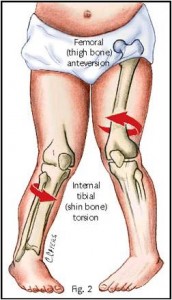- In toeing is more common than out toeing
- In toeing occurs in approx 30% of children up to 4 years old and may resolve as late as 14 years old
- A child may appear to out toe if there is excessive foot pronation
In toeing means that the feet turn inward instead of pointing straight ahead during walking or running. In toeing almost always corrects without treatment as the child grows older.
There are various causes for in toeing which is relative to where the change in alignment is centered – metatarsus aductus, internal tibial torsion and internal femoral torsion are the most common causes.
Metatarsus adductus, more commonly known as “pigeon toes”, is where all toes are in normal alignment apart from the big toe, this instead points or curves inwards. This is generally caused by tightness of the adductor hallucis muscle which normally holds the big toe in a straight position.
Internal tibial torsion – This can occur if the child’s lower leg bone (tibia) twists out of normal alignment. This can occur before birth, as the legs rotate to fit in the confined space of the womb. After birth, the legs should gradually rotate to align properly. Tibial torsion is present if the lower leg remains turned in. When the child begins walking, the feet turn inward because the tibia in the lower leg, just above the foot, points the foot inward. As the tibia grows taller, it usually untwists.
Internal femoral torsion – this is when the femur (thigh bone) rotates inward more than outward at the hip joint. Children with this will often sit in a “W” position on the floor rather than sitting with their legs crossed as its more comfortable. This correlates to in toeing as the child will subconsciously rotate their femur inward for comfort while walking causing the lower leg to become effected evident with the feet pointing inward




